new posts in all blogs
Viewing: Blog Posts from the New category, Most Recent at Top [Help]
Results 12,001 - 12,025 of 69,914
How to use this Page
You are viewing the most recent posts from blogs in the New category in the JacketFlap blog reader. These posts are sorted by date, with the most recent posts at the top of the page. There are hundreds of new posts here every day on a variety of topics related to children's publishing. Scroll down through the list of Recent Posts in the left column and click on a post title that sounds interesting. Click a tag in the right column to view posts about that topic. You can view all posts from a specific blog by clicking the Blog name in the right column, or you can click a 'More Posts from this Blog' link in any individual post.
The recent rounding-up and detention of some Iranians for posting a video on YouTube of themselves dancing to an innocuous pop song -- see, for example, the story in The Guardian -- suggests the local authorities still aren't showing much cultural flexibility -- and yet a few days ago at IBNA "scholar, author and translator of philosophy Babak Ahmadi" is quoted as saying about the current state of literature and (non-reading) in the country:
I think we have to trace a resolve to this problem somewhere else, where the government is not honest with people and books are irrationally censored, so people are no longer interested in books
Admirable of him to say -- and them to be able to print -- that maybe the governmnt should at least explain what's okay, and what isn't.
Open criticism and discussion seems to be a good first step to sorting things out .....
Read the rest of this post
There are only a few books by non-literature Nobel laureates under review at the complete review, but A Universe of Consciousness, co-written by Gerald M. Edelman, is one of them.
He's now died; see the obituary by Bruce Weber in The New York Times.

When Amazon purchased leading digital comics provider Comixology and subsequently removed in-app purchases from Comixology on iOS devices to avoid paying Apple a 30% cut, the big question was whether Apple would notice and act or not. Motley Fool has a typical think piece on the matter here.
While Comixology absolutely put digital comics on the Apple map—CX was the #1 grossing non-game app on iPads, and Apple had definitely started chatting up some digital comics content providers—the total amount of money involved may not have been a painful loss to Apple. For instance, using back of the envelope math, Motley Fool guess that digital comics were a $75 million a year business, and Apple’s cut of that would be $22.5 million. Not exactly chump change, but really little more milk money for the oft inscrutable behemoth that is Apple.
However, a Beat correspondent just forwarded a promotional email from iBooks with the headline “Comics: Injustice Issues Free + Series Starters” which offers an iBook store deal on Injustice Among Us, which has been one of the top selling digital comics for months and months. As you can see from the screen shot, Apple is offering the first issues of both Injustice and Injustice Year Two as “jump on” issues. They also have special “starter” sections for Marvel, Dark Horse and IDW— all publishers with their own apps run via Comixology. Here’s the hype:
The DC Universe goes through a seismic shift after Superman faces a shocking tragedy. In this popular series, the last son of Krypton enforces peace on Earth by any means necessary, forcing the world’s heroes to decide if they’re with him — or against him.

Get the first issues of both Injustice and Injustice: Year Two free for a limited time.
Individual issues of Injustice are still 99 cents. Graphic novels are at the ebook price, not the Amazonian deep discounts. So yeah maybe Apple wants to stay in the comics sale game?
That potential $22.5 million in revenue may not even be the biggest enticement for Apple to get into the game via iBooks, but rather the chance to stick it to rival Amazon. In the wake of the Comixology/Amazon deal, we hear publishers are looking for other e-outlets in at least a casual fashion, and Apple would make a pretty good replacement date for the tablet prom. And a war to see who could sell more digital comics between Amazon and Apple, would be pretty much a dream scenario for any medium.
Developing…
More Silverstein videos compiled over at Open Culture.

By: Julia Callaway,
on 5/24/2014
Blog:
OUPblog
(
Login to Add to MyJacketFlap)
JacketFlap tags:
History,
Japan,
Language,
japanese,
Asia,
Linguistics,
kanji,
*Featured,
oxford dictionaries,
japanese language,
oxfordwords blog,
Dictionaries & Lexicography,
kotodama,
Naoko Hosokawa,
sino,
loanwords,
koku,
shounin,
saityou,
Add a tag
By Naoko Hosokawa
In Japan, there is a common myth of the spirit of language called kotodama (言霊, ことだま); a belief that some divine power resides in the Japanese language. This belief originates in ancient times as part of Shintoist ritual but the idea has survived through Japanese history and the term kotodama is still frequently mentioned in public discourse. The notion of kotodama is closely linked with Japanese linguistic identity, and the narrative of kotodama has been repeatedly reinterpreted according to non-linguistic factors surrounding Japan, as well as the changing idea of “purity” of language in Japan.
Ancient face
The term kotodama literally means “the spirit of language” (koto = language, dama (tama) = spirit or soul). It is a belief based on the idea of Shintoism, the indigenous religion of Japan which worships divinity in all natural creation and phenomena. In ancient Japan, language was believed to have a spirit, which gives positive power to positive words, negative power to negative words, and impacts a person’s life when his or her name is pronounced out loud. Wishes or curses were thus spelled out in a particular manner in order to communicate with the divine powers. According to this ancient belief, the spirit of language only resides in “pure” Japanese that is unique and free from foreign influence. Therefore, Sino-Japanese loanwords, which were numerous by then and had a great impact on the Japanese language, were eschewed in Shintoist rituals and Japanese native vocabulary, yamatokotoba, was preferred. Under the name of kotodama, this connection between spiritual power and pure language survived throughout Japanese history as a looser concept and was reinvented multiple times.
War-time face
One of the most significant historical moments in which the myth of kotodama was reinvented was during the Second World War. In order to strengthen national solidarity, the government reintroduced the idea of kotodama, coupling it with the idea of kokutai (国体, こくたい, koku = country or nation, tai = body), the Japanese national polity. The government promoted the idea that the use of “pure” and traditional Japanese language was at the core of the national unity and social virtue that is unique to Japan, while failing to use the right language would lead to violation of the national polity. Under the belief of kotodama, proposals to abolish or reduce the use of kanji (Chinese characters), which had been introduced since the modernization of the country in the second half of the nineteenth century, were fiercely rejected. Instead, the use of kanji as well as traditional non-vernacular orthographic style was encouraged. Furthermore, based on the kotodama myth, the use of Western loanwords was strictly banned as they belonged to the language of the enemy (tekiseigo) and those words were replaced by Sino-Japanese words. For example, the word ragubî, which is the loan from the English word “rugby,” was replaced by tôkyû, a Sino-Japanese word meaning “fight ball.” The word anaunsâ, which is the loan from the English word “announcer,” was replaced by hôsôin, a Sino-Japanese word meaning “broadcasting person.”
It is interesting to note that the kotodama myth was reinvented to encourage the use of Sino-Japanese elements, whereas in the ancient belief the myth promoted the Japanese native elements and eschewed Sino-Japanese elements. In other words, Sino-Japanese was redefined as the essential element of the “pure” and “traditional” Japanese language. Even the movements to simplify the Japanese orthographic system by abolishing the use of Chinese characters and using only kana (phonetic syllabaries) to write Japanese were considered to be violations of kotodama, despite the fact that kana was invented in Japan. This complete reversal of the position of Sino-Japanese elements can be explained by the belief that the increasing use of Western loanwords was creating a new threat to the Japanese linguistic identity. The idea of kokutai, along with other militarist propaganda, was stigmatized in post-war Japanese society and faded away. However, the idea of kotodama survived through the post-war democratization period into contemporary Japan with yet another face.
Contemporary face
You still hear the word kotodama today. A song titled “Ai no Kotodama [Kotodama of Love] – Spiritual Message” performed by a Japanese pop rock band, Southern All Stars, is a well-known hit which has sold over a million since it was recorded in 1996. Above all, one frequently sees the term kotodama used in public debates on the subject of foreign loanwords (gairaigo, which excludes Sino-Japanese loans). For example, an article from a nationwide newspaper stated that “loanwords are threatening the country of kotodama.” Thus the idea of kotodama is still linked to the purity of language in contrast to Western loanwords but, unlike the link between kotodama and political identity of the country made during World War Two, it seems that the myth is now linked to its cultural and social identity while recent waves of globalization have increased the diversity within the contemporary Japan.
The diversity of Japanese society goes hand in hand with the diversity of its vocabulary, which we can see from the rapid increase of loanwords in Japanese. However, at the same time, this increases a sense of insecurity in relation to the linguistic and cultural identity of Japan. As a result, the ancient myth of kotodama has been reinvented as a way to manifest Japanese linguistic identity through the idea of a “pure” language. Kotodama has no fixed definition, and continues to transform as Japanese society undergoes changes. It is questionable if the Japanese still really believe in the spiritual power of language — however, the myth of linguistic purity persists in the mind of the Japanese through the word kotodama.
Naoko Hosokawa is a DPhil candidate in Japanese sociolinguistics at the University of Oxford. A version of this article originally appeared on the OxfordWords blog.
Subscribe to the OUPblog via email or RSS.
Subscribe to only language articles on the OUPblog via email or RSS.
The post Kotodama: the multi-faced Japanese myth of the spirit of language appeared first on OUPblog.


By: Maggie Belnap,
on 5/24/2014
Blog:
OUPblog
(
Login to Add to MyJacketFlap)
JacketFlap tags:
Books,
History,
Videos,
youtube,
World,
world war I,
Europe,
first world war,
*Featured,
great war,
verdun,
Battle of Verdun,
Paul Jankowski,
jankowski,
67f04pq,
dc3lneqwxu0,
5ta8thfy00w,
ttmquua5,
stavinksy,
Add a tag
The battle of Verdun began on 21 February 1916. It did not end until December of that year. It was a place of no advance and no retreat, where national resources continued to pour in, extending the slaughter indefinitely. Paul Jankowski, leading French historian and author of Verdun: The Longest Battle of the Great War, examines Verdun in a new, unique way, using both French and German sources with equal weight. Jankowski questions why Verdun holds such a high status in World War I when it sparked no political changes, had an indecisive outcome, and was not the bloodiest of the war. He explains not only the total history of the battle, including leaders, plans, technology, and combat, but also analyzes and stresses the soldiers’ experiences and the impact of war on national memory.
Why did the battle of Verdun begin?
Click here to view the embedded video.
“Verdun:a hell that was all its own.” – Paul Jankowski
Click here to view the embedded video.
“Nobody could win…but nobody could afford to lose…” – Paul Jankowski
Click here to view the embedded video.
Results of Verdun
Click here to view the embedded video.
Paul Jankowski is Raymond Ginger Professor of History at Brandeis University. His many books include Verdun: The Longest Battle of the Great War, Stavinksy: A Confidence Man in the Republic of Virtue and Shades of Indignation: Political Scandals in France, Past and Present.
-Subscribe to OUPblog via email or RSS.
-Subscribe to only history articles at OUPblog via email or RSS.
The post Verdun: the longest battle of the Great War appeared first on OUPblog.

They announced the winners of the: "27th Annual Translation Prize for superior English translations of French works published in 2013" awarded by the French-American Foundation and the Florence Gould Foundation.
In the fiction category Adriana Hunter's translation of Eléctrico W by Hervé Le Tellier took the prize.
(There's a non-fiction category too; Alison Dundy and Nicholas Elliott won for their translation of The Falling Sky by Davi Kopenawa and Bruce Albert; see, for example, the Harvard University Press publicity page.)
I tend to stay away from the controversies-of-the day that everybody weighs in on (sorry, no 'trigger warning'-commentary hereabouts), but the Amazon.com/Hachette dispute is hard to avoid.
Apparently folks are surprised and upset that Amazon.com is playing hardball/dirty in negotiating a new arrangement with mega-publisher Hachette, delaying -- or at least really taking their time -- with orders for Hachette-titles (which does seem pretty petty) and making it impossible to pre-order forthcoming Hachette titles (which seems .. well, not really a big deal).
For an overview see, for example, Amazon Flexes Its Muscles in Fight Against Publishers, by David Streitfeld and Melissa Eddy in The New York Times.
One can, and should debate these tactics, but what I have a bit of trouble with is the voices of surprise and hand-wringing.
So, for example, Farhad Manjoo writes -- also in The New York Times -- that Amazon's Tactics Confirm Its Critics' Worst Suspicions, as if this were something new or unexpected.
But Amazon has done this before -- Amazon Removes Macmillan Books The New York Times reported in 2010.
In Germany they did the same with Diogenes more than a decade ago -- see, for example, the (German) report in Der Spiegel.
Come on, folks -- this is how they operate.
And while they seem to be getting bad PR, annoying writers, and while Manjoo and many others argue: "There are a couple obvious reasons this is a bad strategy", surely they've done the cost/benefit sums -- and are well aware how short consumers' memories are -- and decided it's worth it.
(As I've mentioned many times before, the 'business' that is publishing (or the way publishers go about pretending to be businesses) completely baffles me; the current situation does little to help reassure me that anyone of any competence is involved (unlike Amazon, who, like it or not, know how to play).
I'd like to have more sympathy even for a juggernaut like Hachette but find that during the course of these negotiation they apparently haven't even disabled/removed Amazon from their 'Where to buy this book'-reseller pages -- see the one for 'The Silkworm' by Robert Galbraith, one of the books that is currently unavailable for pre-order at Amazon -- which suggests they aren't even serious about asserting their position (but rather are offering a little posturing for show but basically will roll over soon enough).
Come on, guys, even if it's just symbolic, put a little effort into at least pretending you're taking some sort of stand .....)
I'm not really sure what people expect, now.
We've all helped create the monster, but it's not like we weren't aware of what monstrosities to expect from it.
(Again: publishers don't seem to really understand how business works, so when a business acts like ... a business (using its market position and power to exact better terms) they're suddenly shocked ?)
I am not a very good capitalist-consumer, even of books: publishers generously send me most that I ask for, free of charge (much appreciated !); I borrow about fifty books a year from the library, and buy maybe fifty to a hundred more -- but practically all used.
Other than the occasional gift-purchase, I haven't paid retail for a book in a long, long time (but when I do pay retail I do so at a local bookstore).
The only title I have ever purchased directly from the American Amazon.com was in cashing in a ten-dollar coupon provided by them, well over a decade ago; I have bought two or three other books from Marketplace sellers over the years -- and I do cash in, in books, some of the Amazon-earnings I make as an Amazon-affiliate (getting a commission when readers click on the Amazon links on this site) from the German and French Amazons.
(I do make some -- though by now relatively little -- money via the Amazon-click-throughs on the site, so I do have some vested interest in people using Amazon.)
All of which is to say I have no idea how (more normal) consumers will react to the Amazon shenanigans.
I suspect memories will be short -- if indeed they even notice.
I suspect Amazon will continue to get its way, more or less.
I do hope publishers get a bit more aggressive in their negotiating tactics.
Or learn some tactics .....
Read the rest of this post
The most recent addition to the complete review is my review of Geoff Nicholson's new novel, The City under the Skin.
That's the eighteenth (!) Geoff Nicholson title under review at the complete review; only Naguib Mahfouz (23) is better-represented.

WHOOPS here’s the bad news to get you off on the weekend — Edgar Wright has left Ant-Man the film he’s been working on for…like…EIGHT YEARS. Marvel released a short statement and Latino Review had a short mysterious addendum
Marvel and Edgar Wright jointly announced today that the studio and director have parted ways on ANT-MAN due to differences in their vision of the film,” a statement read. “The decision to move on is amicable and does not impact the release date on July 17, 2015. A new director will be announced shortly.
Stay tuned as more develops! Will update the story as I find out more. I been hearing things but coughed it up to gossip. Unfortunately, it was true. I’m just shocked that production being this close that Wright bails.
Okay will you all go back and read this post by moi again? Marvel movies are good but homogenous and Edgar Wright—Scott PIlgrim, Shaun of the Dead, The World’s End—was an autuer. Not a Spielberg-esque auteur, but a guy who makes movies that are his OWN.
And MArvel had no room to do that. I’m guessing here but…is there any other way it could have played out?
Wright has been attached to Ant-Man since 2006 and even showed footage at Comic-Con a few years ago. On paper this looked like a weird, quirky film. Maybe that’s not what Marvel was looking for.
Ant-Man is still slated to come out in 2015, starring Paul Rudd, Michael Douglas, Evangeline Lilly, Corey Stoll, Michael Pena and Patrick Wilson.
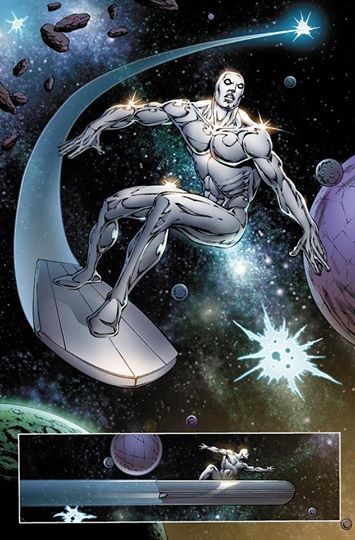
Here’s an upbeat note as we head into the three-day weekend. There had been some recent mini-kerfuffles between Marvel and artist Jim Starlin, whose cosmic comics throughout the 70 and 90s and creations Thanos, Gamora and so on are so so integral to Marvel’s future movie plans. Starlin was back at Marvel happily working on a bunch of projects, including a Thanos original GN. All seemed well, but then a brief dust-up flared, concerning Starlin not getting a mini-series approved because of Marvel continuity issues, and then some pushback from Tom Brevoort and…yeah a mini kerfuffle.
But according to Starlin’s FB page, it was just a temporary thing, and it’s all good once more:
I would like to let folks know that Marvel and I will be doing further work together. Details on future projects will have to wait until a more appropriate time. Just wanted everyone to know that all is good.
I’m really happy to hear this, as the good Starlin/Marvel working relationship seems to be mostly mutually satisfactory and not a batteground, unlike the ongoing legal battles and acrimony with so many older creators.
Starlin accompanied this post with an image of the Silver Surfer—co-star of Thanos: The Infinity Revelation—which could be a hint or just a pretty picture.
And now you know….the rest of the story.

Want.
Hasbro’s Marvel exclusive are EXCEEDINGLY “cosmic” this year:
Priced at $99.99, a set of Marvel Legends Infinite Series 6-inch figures is based on the Marvel story line “The Thanos Imperative” — included are theInhumans’ Black Bolt and Medusa, Gladiator, Blastaar and Star-Lord from theGuardians of the Galaxy. They all arrive in a special-edition box designed to look like the Galactus Engine from the comics.
Another pack of 3¾-inch figures ($74.99) comes from the classic miniseries TheInfinity Gauntlet and features Nebula, Starfox, Mistress Death and the cosmic villain Thanos, who comes with his own Infinity Gauntlet. But he’s not the only guy who gets one — Marvel’s looking out for fans, too, by including a wearable foam Infinity Gauntlet glove in case you want to rule outer space yourself.
You’ll want to have these around when AVENGERS 2 opens for sure.
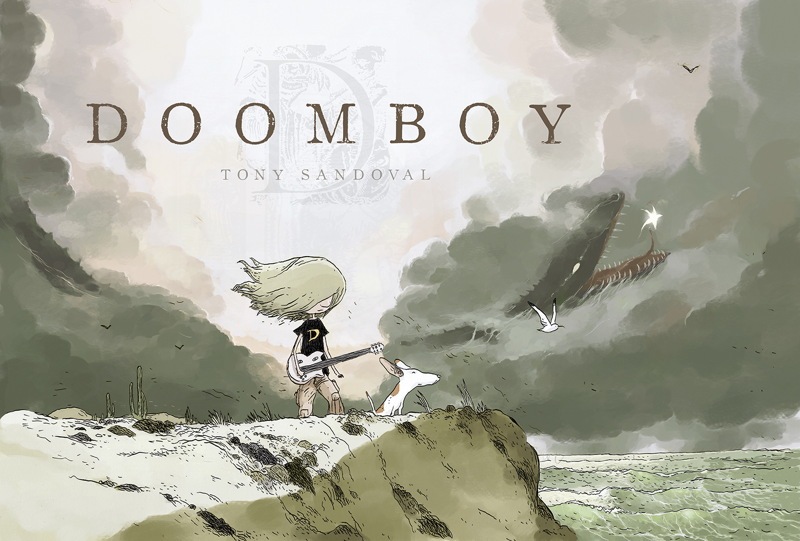
Magnetic Press continues its mission to bring a bunch of great looking French comics to the US with announcement they’ll b publishing Tony Sandoval’s DOOMBOY, an official selection at the 2012 Festival d’Angouleme and winner of the “Coup de Coeur” Youth Jury prize. Magnatic’s first ever English edition will be out in September.
The story concerns an ordinary teenage boy who loves metal music. After his girlfriend dies, he becomes Doomboy, and plays heartfelt music to her. But when other people hear this music, “Doomboy” becomes a legend.
Sandoval is known for his other books Nocturno, The Corpse And The Couch, and his most recent work, The Sea Serpent.
As you can see from the six page preview below, Sandoval’s work, in addition to being gorgeous, is a teeny bit reminiscent of the recent hit Beautiful Darkness. French comics have been a hard sell in the US for a long time, but I think that is changing quickly because of more comics in a more up to date style.
More information is available at the Magnetic website.
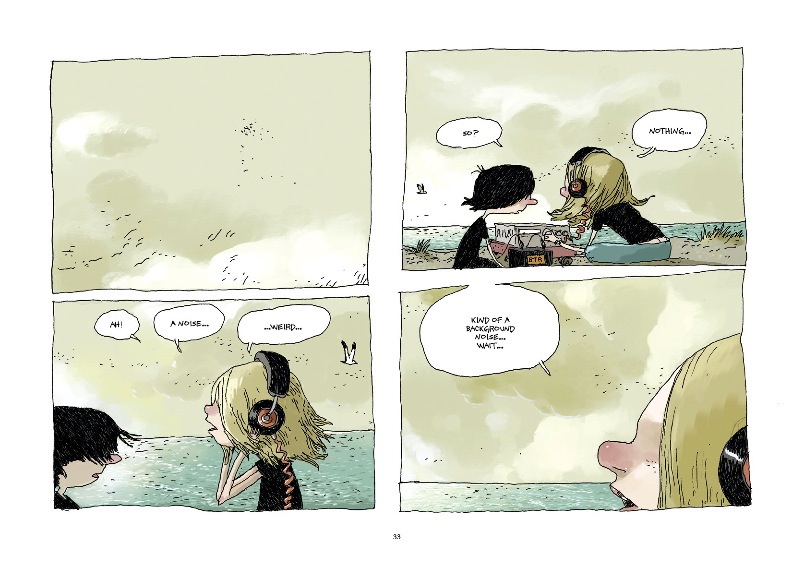


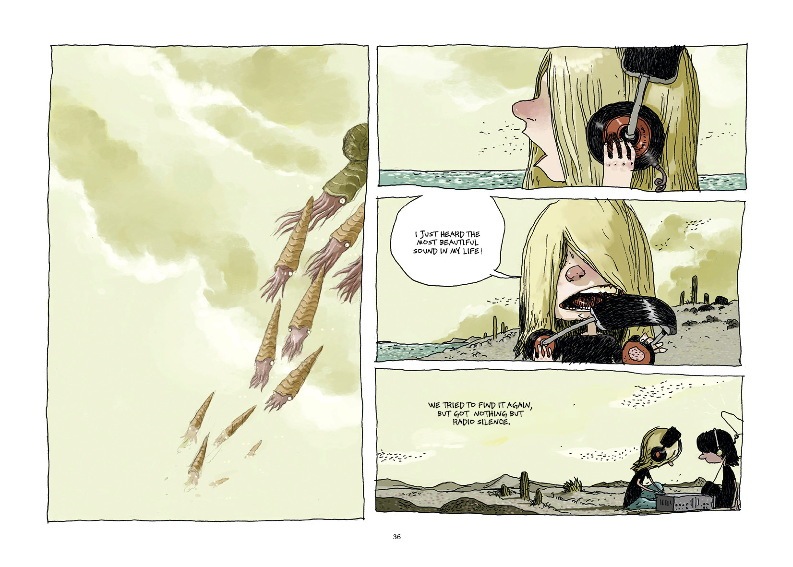


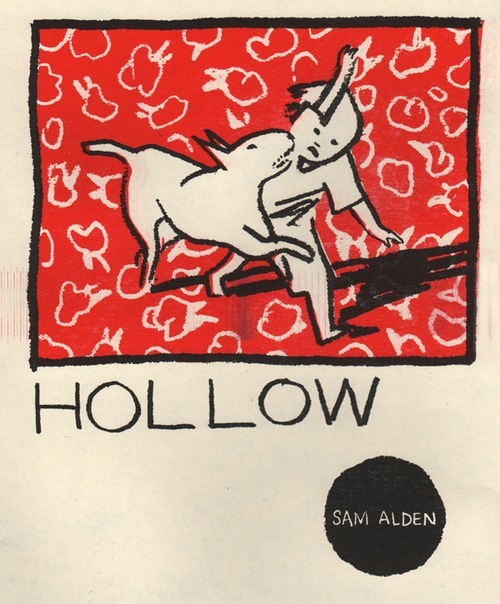
Sam Alden has just posted the first part of a longer story called HOLLOW part I—it’s a digital version of a comic he had print copies of for sale at TCAF. It’s interesting to see him developing an almost animated style for this—like reading storyboards as comics.

I shuddered when I read that panel.
Speaking of Alden, some glowing reviews for his work. Tom Murphy reviews Wicked Chicken Queen for Broken Frontier:
Like a strange lysergic Richard Scarry book, each page is filled with little vignettes of how this weird little island society works. Even the island itself is a protean organic landscape. (Click to enlarge) In addition, the apparent simplicity of the narrative masks a rich metaphorical resonance that invites multiple readings to get to the heart of what Alden is saying about history, power and society.
And Rob Kirby on It Never Happened Again in TCJ:
The two stories featured in It Never Happened Again display Alden’s impressive strengths as a visual storyteller. They feature completely different settings and characters, but have in common protagonists in search of things ineffable—perhaps unattainable. Each story casts its own strange sort of spell, making for a very strong debut book.
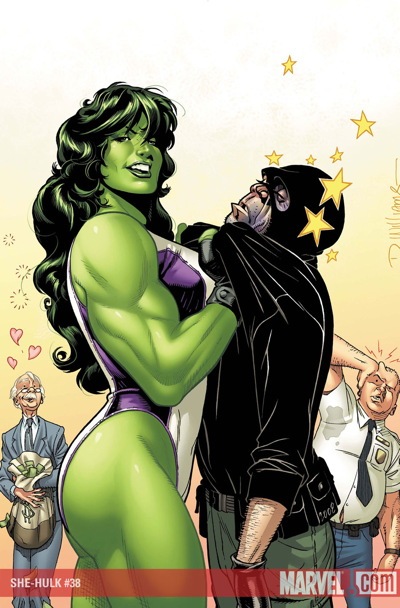
In case you missed the Flight 370 of the comics internet, here’s a post to get you totally up to speed on the latest developments!
May 21st 12:10 pm Mary Sue contributor Alan Kistler posts a transcript of a podcast from the night before called Scriptnotes, a screenwriting podcast run by John August. On this episode, called The Summer Superhero Spectacular, August and Craig Mazin talk with Legend of Conan screenwriter Andrea Berloff, Captain America the Winter Soldier scribes Christopher Markus and Stephen McFeely, and David S. Goyer, probably the single most important guy in the entire DC/Warner Bros film universe, author of the stories of Blade I, Blade II, Blade III, Batman Begins, The Dark Knight, The Dark Knight Rises, Man of Steel, Batman v Superman: Dawn of Justice (League), executive producer of the upcoming Constantine tv show, and a man with a hand in just about every single DC related thing that goes on at Warner Bros.
Kistler transcribed the past of the podcast where Mazin called She Hulk “She slut” and Goyer chimed in with the following:
Goyer: I have a theory about She-Hulk. Which was created by a man, right? And at the time in particular I think 95% of comic book readers were men and certainly almost all of the comic book writers were men. So the Hulk was this classic male power fantasy. It’s like, most of the people reading comic books were these people like me who were just these little kids getting the s**t kicked out of them every day… And so then they created She-Hulk, right? Who was still smart… I think She-Hulk is the chick that you could f**k if you were Hulk, you know what I’m saying? … She-Hulk was the extension of the male power fantasy. So it’s like if I’m going to be this geek who becomes the Hulk then let’s create a giant green porn star that only the Hulk could f**k.
Proving that he his misunderstanding green characters also extends to DC characters, Goyer then took a few swipes at Martian Manhunter, a character he will be writing in the upcoming Justice League movie, by most accounts, asking “How many people in the audience have heard of Martian Manhunter?” and after some people responded in the affirmative saying “How many people that raised their hands have ever been laid?”
Ouchie.

May 21st 12:11 pm: All hell breaks loose on the internet as Twitter, show biz sites, comics sites and every site except the one you are reading cry out in unison to mock the man who will write the Justice League Movie and to, of all things, defend She-Hulk. As many pointed out, Goyer has grossly misrepresented She-Hulk — she’s Bruce Banner’s COUSIN not his fuck buddy! And she does have kind of a dumb origin: she was created by Stan Lee and John Buscema to copyright the idea of a “female Hulk” since Marvel feared The Incredible Hulk tv show would spin off into a female version, the way the Six Million Dollar Man had with The Bionic Woman. (these are primitive times we’re talking about.) But as hundred of fans pointed out, She-Hulk, in her day job as attorney Jessica Walter, had actually become one of the most well rounded female superheroines on the stands, with respected runs by Dan Slott and now Charles Soule; heck, even the John Byrne run had its moments.
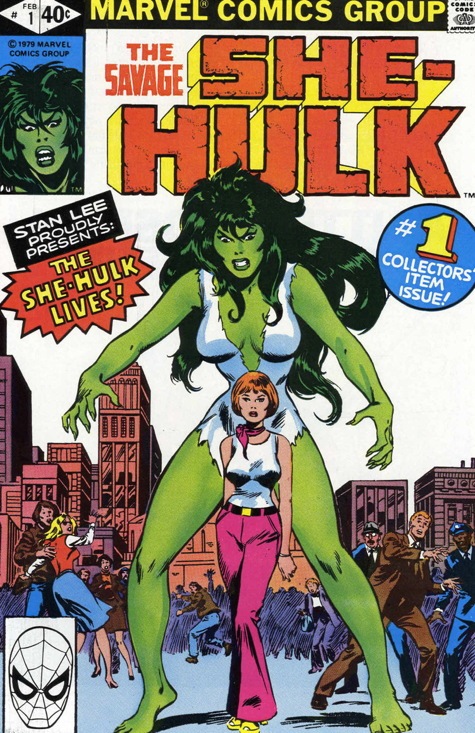
May 21st 4:15 pm: : The Washington Post’s Alyssa Rosenberg hammers the above home with a fantastic post called She-Hulk is a feminist hero, not a male fantasy where she points out that She-Hulk, almost alone among superheroines, is a FEMALE power figure who is so strong she’s freed from all fear and able to enjoy her own sexuality with an agency rarely seen in any female characters:
She-Hulk was sexy, too, of course. But what Goyer seems to miss is that in her earliest and best story lines, She-Hulk’s sexuality is her own. She is not some brain-dead courtesan, but a swashbuckling heart-breaker. Her first love interest is a neighboring medical student, a younger hunk. In Slott’s “Single Green Female” stories, Shulkie brings home a male super-model and then has to figure out how to make sure her Adonis does not get too attached.
The best She-Hulk sex and romance stories succeed because they make an important distinction. She-Hulk is not a male fantasy of how sexual liberation works, where women focus more on making men happy than on their own pleasure. Rather, she is an adventuress with a clear sense of her own gratification and joy.
AND NOW SURPRISE FLASHBACK! In a post on Four Color Princesses by Dee Emm Elms called “People are gonna stare no matter how I dress!” Elms makes a pretty powerful argument that despite her often scanty clothing and art by Greg Horn and Greg Land and the VAST amount of She-Hulk fetish art out there, she is still an icon who stands in for the empowerment of women, representing self-reliance and the power to fight back, a fantasy that a lot of women, particularly battered woman, may find very inspiring. Yes, THAT Shulkie.

Oh yeah, while I was image surfing I found all kinds of amazing images of She Hulk. And I found this one of a little kid whose parents decided to dress their young daughter as She-Hulk. Maybe a little odd…but adorable.
BACK TO THE TIMELINE:
May 21st, 5:45 pm: The showbiz internet begins to question why Goyer is even writing Wonder Woman for the Batman V Superman: Dawn of Justice (League) movie, whose unfortunate title was just announced earlier in the day. Ross Lincoln at The Escapist ties his Martian Manhunter comments—which certainly aren’t very flattering to the superhero world—to Warner Bros’ failure in that department:
It’s been said before, but Goyer almost appears to be ashamed that he’s even associated with comic book films. So it is that the best he can come up with, when asked about one of DC’s most interesting properties, is to delete any trace of the his origin story, misunderstand core aspects of his character, and saddle him with a genericized sobriquet so hackish it almost belongs in a Matrix sequel and plot points that reflect the worst cliches of the last 20 years. I can’t argue that Martian Manhunter isn’t as well known as Superman, Batman or Wonder Woman. But using obscurity as an excuse to ignore him shows a painful lack of imagination. Marvel has made billions producing movies about ancient Norse gods and talking raccoons. Meanwhile, DC’s attempt to copy Marvel is being run by someone who thinks the lone survivor of an ancient Martian civilization is too nerdy for audiences to accept. Make of that what you will.
May 21st, 11:11 pm: Rosenberg’s colleague, Michael Cavna tracks down She Hulk co-creator Stan Lee and asks what he thinks of the controversy. Still sharp Stan responds “Never for an instant did I want her as a love interest for Hulk. Only a nut would even think of that.”
May 21, 11:12 pm: “Stan Lee calls David S Guyer a Nut” headlines begin to fan out over the internet.
May 22, early morning: Current She Hulk scribe (and attorney) Charles Soule begins to tweet about the controversy:
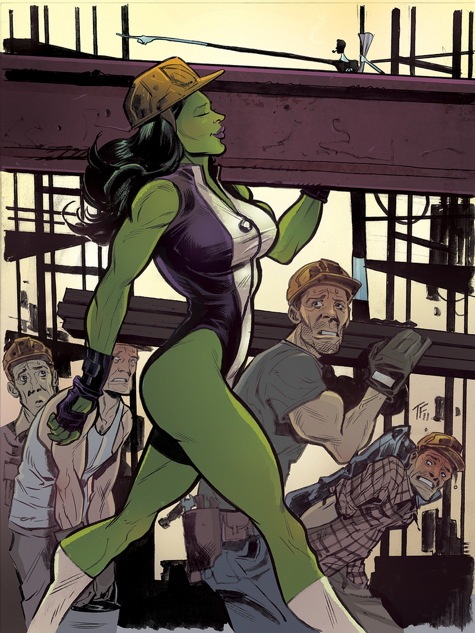
May 22nd, late afternoon: The original cause of the kerfuffle, podcaster.screenwriter John August Craig Mazin, finally speaks up and says when he called the She-Hulk a She-slut, he was descrying her sexist portrayal, not slut-shaming her:
First off, my point wasn’t that I think She-Hulk is a slut. I don’t. I don’t think anyone is a slut. I don’t think there’s anything shameful about female sexuality or the female body.
What I don’t like is the practice of pushing exaggerated images of female bodies to boys because it sells comic books or video games. Women in comics and video games aren’t accidentally drawn over and over and over again with outsized breasts, long legs and narrow waists. It’s marketing. Having a character remark recursively on that marketing doesn’t negate the marketing, of course. It’s a clever way to defuse criticism with grownups while selling issues to hormone-addled boys. John and I have talked about this issue on the podcast before as it relates to video games (specifically in support of the work done by Anita Sarkeesian).
Bottom line: I wasn’t saying that I think she’s a slut. I was saying I think the people who created her were at one time pushing a visual image of Hulk as Slut in order to make money. And I don’t like that. My comment was entirely about the illustration of a fictional character. It was not a reflection of my opinion of the mind or actions of the character.
While the backpedaling here may have carried Mazin all the way to the Arctic Circle, he’s still wrong. And it’s amazing to me that so many guys are getting it wrong. WOMEN LIKE SHE-HULK! Women enjoy a power fantasy! Women would like to be big and strong and not have to give a fuck about anything! Just like guys!
May 23rd, 10:00 am: Weighing in on this who kerfuffle, The Beat must smh yet again at how many people in positions of authority don’t seem to get the first thing about What Women Want In A Superheroine. Not every female character must be a role model. Some are just well-rounded characters who are…fun. FUN, I SAY!!!
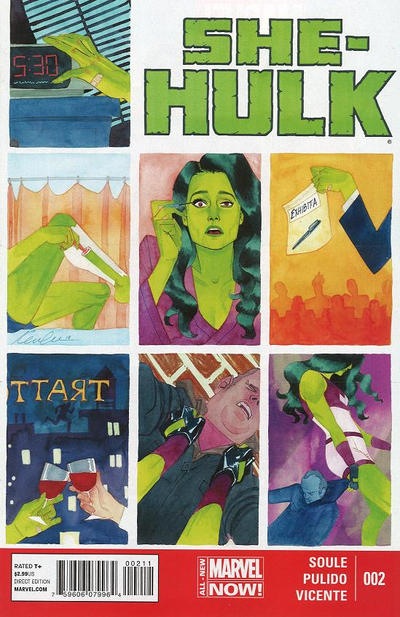
It wasn’t until I started writing this piece that I made a mental comparison of She Hulk and Power Girl. As a kid I always liked She Hulk; but Power Girl’s giant tits repelled me. Why? Both are fun, sexy characters who are superstrong. Neither is shy about showing off their physiques. And yet, aside from the excellent Amanda Conner version, Power Girl is usually portrayed as the passive object of the male gaze. As fetishized as She-Hulk is, if you look at the images on this blog post, she is NEVER passive. She is active, in control, strong, powerful…someone you would like to be for kicks, even if it had its downside, just like it does for Spider-Man, Batman, Superman and every successful superhero. She knows who she is and isn’t ashamed of it.
I dunno, maybe Marvel has it wrong developing Black Widow for films. While She-Hulk might be a tough sell because she’s…a female Hulk, she’s probably Marvel’s freshest, funniest female character. And there’s no one like her anywhere in film or TV.
I listened to a bit of the original podcast, and it’s clear that Goyer and the rest are relaxed and goofing around. Everyone says dumb shit from time to time, but the KIND of dumb shit Goyer used unfortunately fits in with a narrative that isn’t very hopeful for a) a female superhero movie ever being successful in the studio system and b) a DC movie that doesn’t star Batman or Superman ever being successful. I don’t know Goyer or anything about him, but I can guess one thing: This morning, he’s sorry he ever said those things aloud on that podcast.


Here’s an absolutely cool comics event that may help save lives.
Wednesday, May 28th the Hang Dai Studios gang of Dean Haspiel (The Fox, American Splendor), Christa Cassano (The Giant Effect) and Josh Neufeld (The Vagabonds) will be signing at JHU to celebrate Haspiel’s art in FF #5. But it’s also World Blood Cancer Day and in support of photographer/writer/Hang Dai member Seth Kushner, who is being treated for leukemia, they will also host a bone marrow drive. Getting a DNA sample involves a cheek swab, so if you’re up for it and eligible, come on down, see some cool cartoonists and do something for a good cause.
Delete Blood Cancer is going to be here, swabbing and informing folks on how being a donor works. (More on that below!) Even if we don’t find a match for Seth at our event, there are millions of others that could use your help and you as their match!
Come out, get some comics, meet some great people and help out in the name of one of our great, talented friends!
***********************
ELIGIBILITY CRITERIA
We want to make sure that helping a patient get healthy won’t impact your health. Please review the following list of conditions. If you’re not sure about a condition, feel free to call us: 212-209-6700.
You are eligible to register if you are:
between the ages of 18 and 55
in general good health
at least 4’10” and 110 lbs
below the max weight listed for your height on the chart below
https://www.deletebloodcancer.org/fileadmin/user_upload/public/Registrierter_Spender/US_WEIGHTchartweb.jpg
ELIGIBILITY CRITERIA
You are not eligible if you have:
HIV
Hepatitis B or C
Kidney or liver disease
Chronic or severe neck or back problems
Epileptic or other seizure within past year
Diabetes that requires medication
Sleep apnea, breathing problems or severe asthma (daily inhalers are acceptable)
Autoimmune disorders such as lupus, rheumatoid arthritis, multiple sclerosis or fibromyalgia
Or a history of:
heart disease/surgery
strokes, including TIA
blood clotting or bleeding disorders
cancer, with the exclusion of melanoma, breast, bladder, cervical (stage O, in situ) and cured localized skin cancers such as basal cell or squamous cell
JHU Comic Books
32 East 32nd St, New York, New York 10016

By: Julia Callaway,
on 5/23/2014
Blog:
OUPblog
(
Login to Add to MyJacketFlap)
JacketFlap tags:
storytelling,
History,
Journals,
Rwanda,
Oral History,
*Featured,
oxford journals,
Oral History Review,
Alexander Freund,
Erin Jessee,
interview,
Add a tag
On 25 April, we shared an excerpt from the conversation between OHR 41.1 contributor Alexander Freund and OHR board member Erin Jessee regarding Freund’s article, “Confessing Animals: Towards a Longue Durée History of the Oral History Interview.” Below, Freund and Jessee continue their exchange, tackling storytelling in non-Western arenas.
Alexander Freund: I fully agree that conducting interviews with open ended questions that create lots of space for people to tell their stories is an excellent methodology. That way, we develop rapport and get rich and “true” (rather than simply publicly sanctioned) stories. The underlying assumption is grounded in hermeneutics: we will receive a rich text that is as “pure” as possible and can then be interpreted.
I think we can go also beneath these methodological and ethical questions toward fundamental epistemological questions about how the knowledge that we create in an interview is shaped by longue durée processes, and how each interview is another step in learning how to be “right” in the world.
Thus, thinking about the long history of the interview and its connection to confessional practices, the questions about interviewing I have are these: how did we get to the point where, as scientists, we believe it is epistemologically, methodologically, and ethically sound to approach a person (often a stranger) and ask her to “tell me about yourself”? And how have the people we approach come to be more comfortable with one or another kind of responding? Indeed, how, in the first place, have they come to be comfortable with being approached and then giving an account of themselves? And how have we come to a place where, whenever we ask someone, “tell me about your life,” there are basic structural similarities (e.g. narrativity, an account about the self, basic chronology, or frustration about a lack of or expectation of chronology, and personal experiences) in their accounts (at least within specific cultures)?
* * * * *
Erin Jessee: Here again I can appreciate the links you’ve drawn between the practice of oral history and the confessional culture that has developed in many Western nations, especially with regards to the perceived cathartic value of the interview. While I’d like to think that the interviews I’ve conducted in different settings haven’t harmed the people I’ve interviewed, I find our tendency to approach the oral history interview as having similar benefits to narrative therapy troubling. The emotional benefits of the interview, if any, would be incredibly difficult to document, and to my knowledge (and please correct me if I’m wrong), oral historians haven’t taken the time to analyse this in any meaningful way.
And indeed, it fits into more troubling observations about the growing prevalence of storytelling methodologies in the post-conflict nations like Rwanda, Bosnia, and Uganda. While I find storytelling methods are often received as more culturally appropriate in places like Rwanda and Uganda, over the years, I’ve noticed a growing interest in disseminating the outcomes of storytelling-based fieldwork online as a means of educating the public. The recent controversy surrounding Invisible Children’s Kony 2012 mini-documentary — admittedly a poor film that smacks of the white savior industrial complex at its worst — demonstrates that once these materials are made public, there is no way to control how it will be received, replicated, and disseminated by that public going forward. So again, this leaves me wondering whether oral historians can deliver a positive cathartic experience surrounding the interview and its dissemination via digital storytelling platforms. It seems to me that oral historians, and particularly those who work on sensitive subjects, should proceed with caution. And yet simultaneously, it seems everything about current academic and funding climates is pushing us to explore the relevance of digital storytelling and online dissemination for our work.
* * * * *
Alexander Freund: I am interested to hear that there is a “growing prevalence of storytelling methodologies in the post-conflict nations like Rwanda, Bosnia, and Uganda.” Where does this come from? Is that homegrown or a Western import? You say that “storytelling methods are often received as more culturally appropriate in places like Rwanda and Uganda,” but I am always wondering about such claims. Are these backed up by evidence that shows a connection between traditional and current storytelling practices? Is storytelling always just storytelling? Or was there a differentiation of how different kinds of stories got traditionally told? Whenever I hear that something is “culturally appropriate,” I am wondering to what degree this is a colonial fantasy?
* * * * *
Erin Jessee: I think what we’re seeing at present is an attempted blending by foreign researchers, professionals, and civil society organizations, of homegrown and Western methodologies, and by labeling them “storytelling” the expectation is that they will simultaneously appeal to international audiences, local participants, and to be blunt, funding agencies. But you’re right to question whether they are culturally appropriate.
What might have been described as “storytelling” in the past in Rwanda, for example, is actually a complex array of practices that included everything from official histories and stories that were carefully preserved and disseminated by ritual specialists to select members of the royal court, to unofficial histories and stories that could be performed for and by the public. From what I’ve observed, these acts of storytelling are vastly different from the storytelling methodologies (including life history and thematic interviews, focus groups, etc.) commonly used by academics and related practitioners working in Rwanda today. But it’s also important to note that one of the many outcomes of colonialism and later, the 1994 Genocide, is that Rwandans have become quite well-versed in narrative therapy, interviews, and so on, even if they aren’t always comfortable participating in them. Just because current storytelling methodologies aren’t “traditional” for Rwanda, strictly speaking, doesn’t mean they can’t be adapted to make them more culturally appropriate by developing methodological framework in collaboration with Rwandan experts and one’s participants.
But it’s still important to consider expectations — both the researcher’s and the participants’ — when engaging interview and storytelling-based methodologies. Adding to the challenge, many conflicted and post-conflict nations are steeped in transitional justice discourses that, like the interview, are embedded in Western political philosophy and human rights. Bronwyn Leebaw has written an interesting article, “The Irreconcilable Goals of Transitional Justice,” in which she suggests that many of the stated benefits of applying transitional justice mechanisms (such as memorials, trials, and truth and reconciliation commissions) in post-conflict settings are “articles of faith” that claim to facilitate social repair, reconciliation, and so forth, but have never been proven — and indeed often turn out to be false due to the irreconcilable nature of transitional justice’s stated goals. I suspect we’re dealing with a similar phenomenon with regards to the oral history interview, and indeed storytelling more generally. That people should experience catharsis and healing as a result of sharing their experiences during an interview seems to be taken for granted in many parts of the world, and as I’ve mentioned previously, I’m not sure that oral historians have enough solid evidence to support the claim that in the context of an oral history interview, this is indeed the case.
But to return to your paper, it seems the time is ripe for an oral history project that interrogates the foundations of oral history as a (sub-)discipline and its development over time, perhaps by turning the oral history interview on founding scholars and practitioners, as well as analyzing relevant archival materials. And certainly it would be relevant to expand the project to consider the use of interviews in other fields and in cross-cultural settings.
So before we conclude our email exchange, is there anything else you’d like to add?
* * * * *
Alexander Freund: No, I will just say thanks again for your thoughtful response. I agree with all of your points and I am looking forward to a continued online discussion that will hopefully include others interested in this topic.
Alexander Freund is a professor of history and holds the Chair in German-Canadian Studies at the University of Winnipeg, where he is also co-director of the Oral History Centre. He is co-president of the Canadian Oral History Association and co-editor of Oral History Forum d’histoire orale. With Alistair Thomson, he edited Oral History and Photography (New York: Palgrave Macmillan, 2011). He is the author of “Confessing Animals”: Toward a Longue Durée History of the Oral History Interview” (available to read for free for a limited time) in the latest issue of the Oral History Review.
Erin Jessee, in addition to serving on the OHR Editorial Board, is an assistant professor affiliated with the Scottish Oral History Centre (Department of History) at the University of Strathclyde. Her research interests include mass atrocities, nationalized commemoration, spiritual violence, transitional justice, mass grave exhumations, and the ethical and methodological challenges surrounding qualitative fieldwork amid highly politicized research settings. Erin is in the final stages of writing a book manuscript (under consideration with Palgrave MacMillan’s Studies in Oral History series) tentatively titled Negotiating Genocide: The Politics of History in Post-Genocide Rwanda.
The Oral History Review, published by the Oral History Association, is the U.S. journal of record for the theory and practice of oral history. Its primary mission is to explore the nature and significance of oral history and advance understanding of the field among scholars, educators, practitioners, and the general public. Follow them on Twitter at @oralhistreview, like them on Facebook, add them to your circles on Google Plus, follow them on Tumblr, listen to them on Soundcloud, or follow their latest OUPblog posts via email or RSS to preview, learn, connect, discover, and study oral history.
Subscribe to the OUPblog via email or RSS.
Subscribe to only history articles on the OUPblog via email or RSS.
The post ‘Storytelling’ in oral history: an exchange, part 2 appeared first on OUPblog.

The Actuality of the Theologico-Political conference starts at Birkbeck, London, today:
Today’s (post) political thought has been turned into an ethics and a legal philosophy. The business of politics is supposed to promote moral values and ethical policies which are reached either through a discursive will formation (human rights, humanitarianism, freedom etc.) or through the language of rights (original positions, striking a balance between individual rights and community goods, rights as trumps etc.).
Religion can help to revive the political, to re-politicize politics: it can help the construction of new political subjects who break out of the ethico-legal entanglement and ground a new collective space. In early Christianity, the communities of believers created the ecclesia, a new form of collectivity. Asimilar role was played in early Islam by the umma. Paraphrasing Kierkegaard, one can say that we need today the theologico-political suspension of the legal-ethical.
More...

By: ChloeF,
on 5/23/2014
Blog:
OUPblog
(
Login to Add to MyJacketFlap)
JacketFlap tags:
Philosophy,
VSI,
Very Short Introductions,
mercy,
belgian,
morality,
Medical Ethics,
euthanasia,
*Featured,
disagreement,
Health & Medicine,
mercy killing,
Tony Hope,
lorry,
empirical,
Add a tag

By Tony Hope
Science and morality are often seen as poles apart. Doesn’t science deal with facts, and morality with, well, opinions? Isn’t science about empirical evidence, and morality about philosophy? In my view this is wrong. Science and morality are neighbours. Both are rational enterprises. Both require a combination of conceptual analysis, and empirical evidence. Many, perhaps most moral disagreements hinge on disagreements over evidence and facts, rather than disagreements over moral principle.
Consider the recent child euthanasia law in Belgium that allows a child to be killed – as a mercy killing – if: (a) the child has a serious and incurable condition with death expected to occur within a brief period; (b) the child is experiencing constant and unbearable suffering; (c) the child requests the euthanasia and has the capacity of discernment – the capacity to understand what he or she is requesting; and, (d) the parents agree to the child’s request for euthanasia. The law excludes children with psychiatric disorders. No one other than the child can make the request.
Is this law immoral? Thought experiments can be useful in testing moral principles. These are like the carefully controlled experiments that have been so useful in science. A lorry driver is trapped in the cab. The lorry is on fire. The driver is on the verge of being burned to death. His life cannot be saved. You are standing by. You have a gun and are an excellent shot and know where to shoot to kill instantaneously. The bullet will be able to penetrate the cab window. The driver begs you to shoot him to avoid a horribly painful death.
Would it be right to carry out the mercy killing? Setting aside legal considerations, I believe that it would be. It seems wrong to allow the driver to suffer horribly for the sake of preserving a moral ideal against killing.
Thought experiments are often criticised for being unrealistic. But this can be a strength. The point of the experiment is to test a principle, and the ways in which it is unrealistic can help identify the factual aspects that are morally relevant. If you and I agree that it would be right to kill the lorry driver then any disagreement over the Belgian law cannot be because of a fundamental disagreement over mercy killing. It is likely to be a disagreement over empirical facts or about how facts integrate with moral principles.
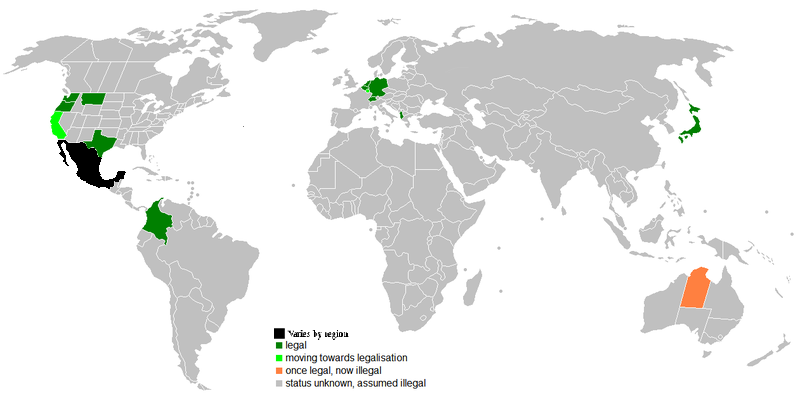
There is a lot of discussion of the Belgian law on the internet. Most of it against. What are the arguments?
Some allow rhetoric to ride roughshod over reason. Take this, for example: “I’m sure the Belgian parliament would agree that minors should not have access to alcohol, should not have access to pornography, should not have access to tobacco, but yet minors for some reason they feel should have access to three grams of phenobarbitone in their veins – it just doesn’t make sense.”
But alcohol, pornography and tobacco are all considered to be against the best interests of children. There is, however, a very significant reason for the ‘three grams of phenobarbitone’: it prevents unnecessary suffering for a dying child. There may be good arguments against euthanasia but using unexamined and poor analogies is just sloppy thinking.
I have more sympathy for personal experience. A mother of two terminally ill daughters wrote in the Catholic Herald: “Through all of their suffering and pain the girls continued to love life and to make the most of it…. I would have done anything out of love for them, but I would never have considered euthanasia.”
But this moving anecdote is no argument against the Belgian law. Indeed, under that law the mother’s refusal of euthanasia would be decisive. It is one thing for a parent to say that I do not believe that euthanasia is in my child’s best interests; it is quite another to say that any parent who thinks euthanasia is in their child’s best interests must be wrong.
To understand a moral position it is useful to state the moral principles and the empirical assumptions on which it is based. So I will state mine.
Moral Principles
- A mercy killing can be in a person’s best interests.
- A person’s competent wishes should have very great weight in what is done to her.
- Parents’ views as to what it right for their children should normally be given significant moral weight.
- Mercy killing, in the situation where a person is suffering and faces a short life anyway, and where the person is requesting it, can be the right thing to do.
Empirical assumptions
- There are some situations in which children with a terminal illness suffer so much that it is in their interests to be dead.
- There are some situations in which the child’s suffering cannot be sufficiently alleviated short of keeping the child permanently unconscious.
- A law can be formulated with sufficient safeguards to prevent euthansia from being carried out in situations when it is not justified.
This last empirical claim is the most difficult to assess. Opponents of child euthanasia may believe such safeguards are not possible: that it is better not to risk sliding down the slippery slope. But the ‘slippery slope argument’ is morally problematic: it is an argument against doing the right thing on some occasions (carrying out a mercy killing when that is right) because of the danger of doing the wrong thing on other occasions (carrying out a killing when that is wrong). I prefer to focus on safeguards against slipping. But empirical evidence could lead me to change my views on child euthanasia. My guess is that for many people who are against the new Belgian law, it is the fear of the slippery slope that is ultimately crucial. Much moral disagreement, when carefully considered, comes down to disagreement over facts. Scientific evidence is a key component of moral argument.
Tony Hope is Emeritus Professor of Medical Ethics at the University of Oxford and the author of Medical Ethics: A Very Short Introduction.
The Very Short Introductions (VSI) series combines a small format with authoritative analysis and big ideas for hundreds of topic areas. Written by our expert authors, these books can change the way you think about the things that interest you and are the perfect introduction to subjects you previously knew nothing about. Grow your knowledge with OUPblog and the VSI series every Friday, subscribe to Very Short Introductions articles on the OUPblog via email or RSS, and like Very Short Introductions on Facebook.
Subscribe to the OUPblog via email or RSS.
Subscribe to only science and medicine articles on the OUPblog via email or RSS.
Image credit: Legality of Euthanasia throughout the world By Jrockley. Public domain via Wikimedia Commons
The post Morality, science, and Belgium’s child euthanasia law appeared first on OUPblog.

They've announced the winner of this year's Independent Foreign Fiction Prize, the leading literary prize for a translation in the UK, and it is: The Iraqi Christ, by Hassan Blasim, translated by Jonathan Wright.
In the UK this was published by Comma Press; see their publicity page, or get your copy at Amazon.co.uk.
In the US, Penguin have bundled it with The Madman of Freedom Square in a volume titled The Corpse Exhibition; get your copy at Amazon.com.
In addition, the IFFP judges:
also wanted to give a special mention to The Mussel Feast, the debut novel by German writer Birgit Vanderbeke translated by Jamie Bulloch
Judge Nadifa Mohamed called it: "a tiny book that leaves a strong impression".
On the occasion of Heywood Hill putting George MacDonald Fraser's Working Library up for sale (2 June to 31 July), publisher Christopher Maclehose reminisces about The derring-do that created Flashman in The Spectator.
I'm a big fan of the Flashman-books -- but Maclehose also suggests:
His best book is Quartered Safe out Here, which I have often heard described as the finest military memoir ever written.
Not all that many books are purchased by visitors to the
complete review via the Amazon.com-links on each page, but
Quartered Safe out Here is one of those purchased in a (still tiny) volume all out of proportion to the limited number of page-views the review gets (other unlikely (relatively) best-sellers:
The Wittgenstein House and
Yoruba Proverbs).
Michael Edwards was actually elected to the Académie française well over a year ago, but he only yesterday finally took his fauteuil -- succeeding the great Jean Dutourd.
Gotta love the Le Figaro headline: Damned, un Anglais à l'Académie française !
The film based on Chimamanda Ngozi Adichie's much-praised Half of a Yellow Sun -- see the official site -- is now making the rounds --- except, apparently, in Nigeria, where it was scheduled to open a month ago but where there's been a hold-up with it getting the necessary stamp of approval from the National Film and Video Censors Board.
At CNN film director Biyi Bandele wonders Why can't Nigerians watch country's biggest movie ?
Meanwhile, the NFVCB have only released a short statement 'explaining':
certain aspects of the film have some unresolved issues which have to be sorted out in accordance with the law and laid down regulations
Well, that clears things up .....
Read the rest of this post
The most recent addition to the complete review is my review of Syl Cheney-Coker's new and long-awaited novel, Sacred River, just out from Ohio University Press.
View Next 25 Posts





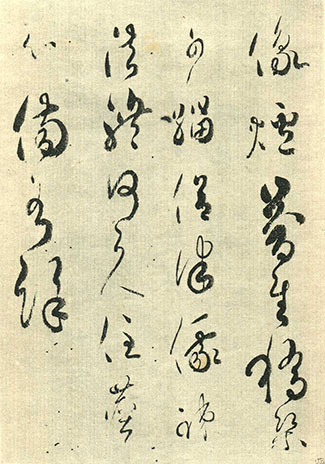























I’m surprised we haven’t heard any moves from Diamond’s Comics Plus app. It’s a pretty great reader, and while it lacks the “guided view” option, its zoom works well enough that that’s not a major issue. It’s definitely a smoother reading experience than iBooks, and they still allow shopping through the app.
According to Yahoo Finance, in the last 12 months Apple generated more than $176 billion in revenue. Their most recent earnings report declared $45.6 billion in revenue for January – March. This puts them on track to do around $200 billion for the calendar year. In light of those numbers I doubt Apple is particularly motivated by the possibility $22.5 million a year in revenue from comics. This probably has more to do with providing a good option on their platform for users.
If Apple were particularly motivated by revenue they would handle much of their business differently. Exhibit A: their “Pro Apps” division (Final Cut Pro and related software, Logic Pro, Aperture). Exhibit B: their sever and storage line. Exhibit C: their line of professional desktop computers. Exhibit D: their…
Are you seriously not posting comments that point out this news post is not factual, as Comoxology offers the same comics for free?
Ah, I see you are allowing comments through moderation now. Anyways, the premise for this post was wrong from the beginning, as it’s simple to verify that Comixology is also offering both Injustice comics for free.